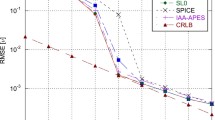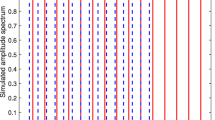Abstract
This paper presents a generalized algorithm called the sub-cross-spectral matrix (SCSM) beamforming technique for the virtual augmentation of an N-channel beamforming array based on sequential computation of the cross-spectral matrix (CSM) terms for localizing stationary signal sources. To this end, first, the diagonal sub-cross-spectral matrices (SCSMs) of the N-channel array pertaining to M different spatial locations were obtained. Next, the off-diagonal SCSMs were systematically computed by directly evaluating the cross-spectral terms between some microphones placed in the array at \(i{\text{th}}\) location \((1 \le i \le M)\) and the remaining microphones placed in the array at \(j{\text{th}}\) location \((j \ne i, \, 1 \le j \le M)\). As a proof of concept, the SCSM beamforming was used to virtually construct a 32-channel planar Underbrink spiral array by sequentially measuring data using \(\left( {\begin{array}{*{20}c} {32} \\ 2 \\ \end{array} } \right)\) microphone pairs. The resultant 2-D beamforming map of a loudspeaker source was found to be nearly identical to the counterpart result produced when data from 32-channel simultaneous measurements were used. The SCSM technique was then extended to increase the density and aperture of a planar array by constructing a virtual 64-channel planar array from 32-channel simultaneous measurements. For the former case, the source maps were found to be identical to the counterpart results obtained from the existing geometric mean and combined CSM algorithms. However, for the latter case, the SCSM beamforming delivered a noticeably improved focal-resolution along the direction in which there was a virtual increase in aperture. For localizing loudspeaker source(s) in a 3-D domain, the SCSM beamforming implemented using two orthogonal Underbrink arrays was shown to deliver a significantly improved resolution (focal lobe) and unambiguous localization because it considers the complete CSM unlike the multiplicative beamforming and combined CSM algorithms which do not account for the phase-information between the two orthogonal arrays.
















Similar content being viewed by others
References
Oerlemans, S., Sijtsma, P., Méndez López, B.: Location and quantification of noise sources on a wind turbine. J. Sound Vib. 299(4–5), 869–883 (2007)
Chiariotti, P., Battista, G., Ettorre, M., Castellini, P.: Average acoustic beamforming in car cabins: an automatic system for acoustic mapping over 3D surfaces. Appl. Acoust. 129(1), 47–63 (2018)
Cantero-Chinchilla, S., Aranguren, G., Malik, M.K., Etxaniz, J., de la Escalera, F.M.: An empirical study on transmission beamforming for ultrasonic guided-wave based structural health monitoring. Sensors 20(5), 1445 (2020)
Mimani, A., Fischer, J., Moreau, D.J., Doolan, C.J.: A comparison of time-reversal and cross-spectral beamforming for localizing experimental rod-airfoil interaction noise sources. Mech. Syst. Signal Process. 111, 456–491 (2018)
Geyer, T., Moreau, D.J.: A study of the effect of airfoil thickness on the tonal noise generation of finite, wall-mounted airfoils. Aerosp. Sci. Technol. 115(6), 106768 (2021)
Merino-Martínez, R., Kennedy, J., Bennett, G.J.: Experimental study of realistic low-noise technologies applied to a full-scale nose landing gear. Aerosp. Sci. Technol. 113, 106705 (2021)
Pan, X., Wu, H., Jiang, W.: Beamforming correction for the singular problem in identifying rotating sources with non-uniform directivity. J. Acoust. Soc. Am. 147(5), 3151–3159 (2020)
Ma, W., Zhang, C.: A frequency-domain beamforming for rotating sound source identification. J. Acoust. Soc. Am. 148, 1602–1613 (2020)
Nikhare, C.P., Conklin, C., Loker, D.R.: Understanding acoustic emission for different metal cutting machinery and operations. J. Manuf. Mater. Process. 1(1), 1–7 (2017)
Singh R., and Mimani, A.: Dereverberation and background noise reduction techniques for improving beamforming maps of engineering noise sources. In: Proceedings of the 9th Berlin Beamforming Conference, Berlin, Germany (June 9–10, 2022).
Gala, D., Sun, L.: Moving sound source localization and tracking for an autonomous robot equipped with a self-rotating bi-microphone array. J. Acoust. Soc. Am. 154(2), 1261–1273 (2023)
Ning, F., Meng, D., Wei, J.: An improved acoustic imaging algorithm combining object detection and beamforming for acoustic camera. J. Acoust. Soc. Am. Express Lett. 2(6), 064802 (2022)
Sarradj, E.: A fast signal subspace approach for the determination of absolute levels from phased microphone array measurements. J. Sound Vib. 329(9), 1553–1569 (2010)
Merino-Martínez, R., Snellen, M., Simons, D.G.: Functional beamforming applied of flyover noise on landing aircraft. J. Aircr. 53, 6 (2016)
Yang, C., Wang, Y.S., Wang, Y., Hu, D.Y., Guo, H.: An improved functional beamforming algorithm for far-field multi-sound source localization based on Hilbert curve. Appl. Acoust. 192, 108729 (2022)
Brooks, T.F., Humphreys, W.M.: A deconvolution approach for the mapping of acoustic sources (DAMAS) determined from phased microphone arrays. J. Sound Vib. 294(4–5), 856–879 (2006)
Sijtsma, P.: CLEAN based on spatial source coherence. Int. J. Aeroacoust. 6(4), 357–374 (2007)
Merino-Martínez, R., Sijtsma, P., Snellen, M., Ahlefeldt, T., Antoni, J., Bahr, C.J., Blacodon, D., Ernst, D., Finez, A., Funke, S., Geyer, T.F., Haxter, S., Herold, G., Huang, X., Humphreys, W.M., Leclère, Q., Malgoezar, A.M.N., Michel, U., Padois, T., Pereira, A., Picard, C., Sarradj, E., Siller, H., Simons, D.G., Spehr, C.: A review of acoustic imaging methods using phased microphone arrays. CEAS Aeronaut. J. 10, 197–230 (2019)
Antoni, L., Yu, J., Leclere, Q.: Spectral matrix completion by cyclic projection and application to sound source reconstruction from non-synchronous measurements. J. Sound Vib. 372, 31–49 (2016)
Pereira, L.T.L., Merino-Martínez, R., Ragni, D., Gómez-Ariza, D., Snellen, M.: Combining asynchronous microphone array measurements for enhanced acoustic imaging and volumetric source mapping. Appl. Acoust. 182, 108247 (2021)
Antoni, J., Liang, Y., Leclère, Q.: Reconstruction of sound quadratic properties from non-synchronous measurements with insufficient or without references: proof of concept. J. Sound Vib. 349, 123–149 (2015)
Yu, L., Antoni, J., Wu, H., Leclere, Q., Jiang, W.: Fast iteration algorithms for implementing the acoustic beamforming of non-synchronous measurements. Mech. Syst. Signal Process. 134, 106309 (2019)
Yu, L., Guo, Q., Chu, N., Wang, R.: Achieving 3D beamforming by non-synchronous microphone array measurements. Sensors 20, 7308 (2020)
Ning, F., Song, J., Hu, J., Wei, J.: Sound source localization of non-synchronous measurements beamforming with block Hermitian matrix completion. Mech. Syst. Signal Process. 147, 107118 (2021)
Ning, F., Hu, J., Hou, H., Yao, K., Wei, J., Li, B.: Sound source localization of non-synchronous measurements beamforming based on the truncated nuclear norm regularization. Appl. Acoust. 191, 108688 (2022)
Hu, D., Ding, J., Zhao, H., Yu, L.: Achieving high-resolution 3D acoustic imaging in a large-aspect-ratio cabin by the non-synchronous measurements. Appl. Acoust. 197, 108953 (2022)
Demyanov, M.A., Bychkov, O.P.: Generalization of the standard beamforming algorithm for identifying acoustic source using asynchronous microphone array measurements. Acoust. Phys. 68(2), 138–146 (2022)
Merino-Martínez, R., Hoff, B. V. D., Morata, D., and Snellen, M.: Three-dimensional acoustic imaging using asynchronous microphone array measurements. In: Proceedings of the 9th Berlin Beamforming Conference, Berlin, Germany (June 9–10, 2022).
Yu, L., Liu, H., Chu, N., Mohammad-Djafari, A., Yang, W.: 3D Non-synchronous measurements with central reference based on revolution and autorotation of spherical microphone array. IEEE Signal Process. Lett. 30, 518–522 (2023)
Morata, D., Papamoschou, D.: High-resolution continuous-scan beamforming. AIAA J. 61(4), 1–15 (2022)
Leclere, Q.: Multi-channel spectral analysis of multi-pass acquisition measurements. Mech. Syst. Signal Process. 23(5), 1415–1422 (2009)
Porteous, R., Prime, Z., Doolan, C.J., Moreau, D.J., Valeau, V.: Three-dimensional beamforming of dipolar aeroacoustic sources. J. Sound Vib. 355, 117–134 (2015)
Arcondoulis, E.J.G., Liu, Y., Xu, P., Chen, N.: An array pairing method for localizing distributed sources by acoustic beamforming. J. Acoust. Soc. Am. Express Lett. 147(1), E7–E12 (2020)
Castellini, P., Sassaroli, A.: Acoustic source localization in a reverberant environment by average beamforming. Mech. Syst. Signal Process. 24, 796–808 (2010)
Wächter, L. K., Ocker, J., Döbler, D., Puhle, C., and Herold, G.: Investigations on beamforming in the wind tunnel using multiple microphone array measurements. In: Proceedings of the 7th Berlin beamforming conference, Berlin, Germany (March 5–6, 2018).
Evans, D., Hartmann, M., Delfs, J.: Beamforming for point force surface sources in numerical data. J. Sound Vib. 458, 303–319 (2019)
Zhou, Y., Valeau, V., Marchal, J., Ollivier, F., Marchiano, R.: Three-dimensional identification of flow-induced noise sources with a tunnel-shaped array of MEMS microphones. J. Sound Vib. 482, 115459 (2020)
Battista, G., Chiariotti, P., Martarelli, M., Castellini, P.: Inverse methods in aeroacoustic three-dimensional volumetric noise source localization and quantification. J. Sound Vib. 473, 115208 (2020)
https://www.larsondavis.com/Products/sound-level-meters/soundadvisor-831C
Prime Z., and Doolan, C.: A comparison of popular beamforming arrays. In: Proceedings of ACOUSTICS 2013, Victor Harbor, Australia (November 17–20, 2013).
Mimani, A., Prime, Z., Moreau, D.J., Doolan, C.J.: An experimental application of aeroacoustic time-reversal to the Aeolian tone. J. Acoust. Soc. Am. 139(2), 740–763 (2020)
Fischer, J., Doolan, C.: Improving acoustic beamforming maps in a reverberant environment by modifying the cross-correlation matrix. J. Sound Vib. 411, 129–147 (2017)
Kinsler, L.E., Frey, A.R., Coppens, A.B., Sanders, J.V.: Fundamentals of Acoustics, 4th edn., p. 142. Wiley, New York (2000)
Sijtsma, P., Merino-Martinez, R., Malgoezar, A.M., Snellen, M.: High-resolution CLEAN-SC: theory and experimental validation. Int. J. Aeroacoust. 16(4–5), 274–298 (2017)
Acknowledgements
The authors gratefully acknowledge the support of the Science Education and Research Board (SERB) India through the project CRG/2022/008404 and would also like to thank Prof. Nachiketa Tiwari for facilitating the use of the anechoic chamber facility.
Author information
Authors and Affiliations
Corresponding author
Additional information
Publisher's Note
Springer Nature remains neutral with regard to jurisdictional claims in published maps and institutional affiliations.
Supplementary Information
Below is the link to the electronic supplementary material.
Rights and permissions
Springer Nature or its licensor (e.g. a society or other partner) holds exclusive rights to this article under a publishing agreement with the author(s) or other rightsholder(s); author self-archiving of the accepted manuscript version of this article is solely governed by the terms of such publishing agreement and applicable law.
About this article
Cite this article
Singh, R., Mimani, A. Virtual Augmentation of the Beamforming Array Based on a Sub-cross-spectral Matrix Computation for Localizing Stationary Signal Noise Sources. Acoust Aust (2024). https://doi.org/10.1007/s40857-024-00322-2
Received:
Accepted:
Published:
DOI: https://doi.org/10.1007/s40857-024-00322-2




